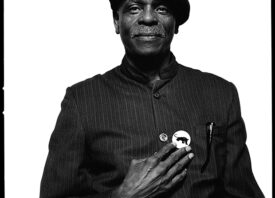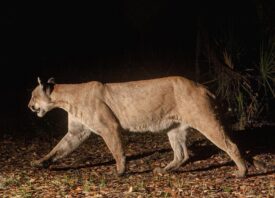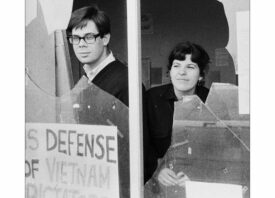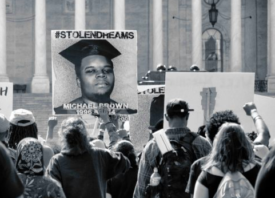Search this site
A Photography Book Honors the Women of the Black Panther Party

Stephen Shames was just nineteen years old when he was first introduced to the men and women who made up the Black Panther Party, and he soon became their go-to photographer. “The Breakfast Program is my favorite memory,” he says now, looking back on those formative years of his life. “It was inspiring to see how happy the children were.”
The Free Breakfast for School Children Program started in 1969. In the first week, the program fed 135 children; in the first year, that number had already risen to 20,000. Shames was able to witness (and document) many of the moments that took place behind the scenes as part of the program—a program that was run largely by the women of the Black Panther Party.
According to estimates, six in ten members of the Black Panther Party were women. Comrade Sisters: Women of the Black Panther Party by Shames and Erika Huggins—a human rights activist and former Panther Party member—celebrates some of their extraordinary stories. The book is the third in Shames’ series of photography from the Black Panther Party, following The Black Panthers and Power to the People: The World of the Black Panthers.
Huggins tracked down and interviewed more than fifty women (and their loved ones) to contribute their words to the book. Many reflect on the vital work they did for the Community Survival Programs, initiatives created by the Black Panther Party to provide essential care to their communities: schools, medical clinics, ambulance access, transportation for seniors, food for school children, and much more.
For example, Cheryl Dawson and her three-month-old daughter spent early mornings at the Free Breakfast for School Children Program. Pamela Ward-Pious worked twenty hours a day, with a focus on the Oakland Community School. Lauryn Williams Jackson, meanwhile, helped out with a massive 10,000-bag food giveaway.
For many of these women, their time in the BPP helped shape the course of their lives. Vivian McMillan, who trained as an EMT, was part of the Free Ambulance Program. Madalynn Carol Rucker worked at the George Jackson People’s Free Clinic and now works in the health and human services field. Evelyn Cheatham went on to provide food to people in need during the holidays for 35 years.
We asked Shames about his time photographing the Black Panther Party, the new book, and the many lessons we can learn from these women today. Comrade Sisters: Women of the Black Panther Party by Stephen Shames and Ericka Huggins is published by ACC Art Books. Get your copy here.

Who were some of the first women leaders of the Black Panther Party who caught your attention?
“Kathleen Cleaver was the first woman leader I met. We remain friends. Professor Charles E. Jones, the noted Panther scholar, notes in the essay he wrote for my first Panther book, The Black Panthers (Aperture, 2006):
‘Women played an essential role within the organization…. six Panther women participated in the May 1967 protest at the Sacramento legislature. Kathleen Cleaver, the first woman to serve on the party’s central committee, joined immediately after Newton’s arrest in October 1967.
‘Women held prominent leadership positions throughout the existence of the organization—Ericka Huggins, the longtime director of the Oakland Community School; Audrea Jones, head of the Boston BPP chapter; and Mary Rhem, founder of the Des Moines, Iowa chapter are but a few examples of female party leadership. Indeed, Elaine Brown, the party’s Chairman from August 1974 to July 1977 is the sole woman to head a protest organization during the Black Power era.’

How and when did your collaboration with Erika Huggins start?
“I knew Ericka Huggins from back in the day, but I did not know her well. When I was working on the book I co-authored with Bobby Seale, Power to the People: The World of the Black Panthers (Abrams, 2016), I interviewed many Panthers, including Kathleen Cleaver and Ericka Huggins, whom I interviewed at her house. She told me that the Panthers were ahead of most of their contemporaries in regards to equality for women and gay rights, saying:
‘Another thing that is part of the legacy of the Black Panther Party is that we were not afraid to look at race, class, gender, and sexual orientation. All of it. Huey wrote in support of the woman’s movement and the gay liberation movement. Who the heck – what black man, what white man, what any man was talking like that in 1970?
‘Huey talked about it in terms that anybody could understand. We had our own gender issues, not so much sexual, but gender issues within the Black Panther Party. But, we worked on that too. We really were ahead in terms of thinking and acting.’
“During that visit, I also was able to see the incredible collection of Black Panther and Movement ephemera Ericka’s partner, Lisbet Tellefsen, collected, and I used some of them in the book. We had many follow-up phone calls while working on the Power to the People book. Ericka, Lisbet, and I became close friends and kept in contact.
“The theme of the 55th anniversary of the founding of the Party in 2021 was the women. That gave me the idea to do a book about the women of the Back Panther Party. I called Ericka and asked her if she wanted to co-author the book with me. She agreed. We did the book together.”

Can you tell us about some of the risks the women in the book faced for doing this life-saving work? Where do you think they found the strength to continue, even in the face of these threats?
“The FBI tailed all of us and spied on all the Panthers. I found out much later, in 2006, that the FBI had an informant, spying on us, inside the communal darkroom I shared with other Berkeley Barb photographers. The FBI and the Nixon Administration also got police departments to assassinate many of the Panthers and had provocateurs who infiltrated the Party and tried to get them to do bad things.
“The women of the Black Panther Party had a love for their community and all people. Their inner strength and commitment to improving life for all oppressed people allowed them to carry on despite the constant threat of arrest and death.
“Vivian McMilan of the Winston-Salem Chapter said in the book, ‘The party understood that due to the plight of Black America, we as a people need to address it. That was what I always felt. And the party addressed that need.’
“Osa Russell White of the Oakland Chapter said, ‘It’s not just my street. It’s the whole Black community that we need to embrace and to teach, and we teach by example. We must love one another.’
“Pamela Ward Pious of the Oakland chapter said, ‘I want women and girls to know that we can and will make a difference.’
“These three examples illustrate the commitment of the women and their love for the community. The Panthers believed the revolution they wanted had to be motivated and guided by love. That transcendent ideal—that love—allowed them to serve the community body and soul. It gave them the strength to continue in the face of COINTELPRO, the government’s campaign of intimidation and lies.”

What do you remember most about meeting Bobby Seale and Huey P. Newton, the co-founders of the Black Panther Party?
“The first time I saw Bobby Seale and Huey Newton was on April 15, 1967, during the Spring Mobilization to End the War in Vietnam. My father had come up from Los Angeles, and we were marching together through the streets of San Francisco when my eye caught Bobby and Huey in their leather jackets selling Mao’s Red Book. Their charisma and confidence captivated me. I took one frame.
“I do not remember my first conversation with Bobby or exactly how I started documenting the Panthers as an ‘insider.’ The relationship just grew. The Panthers were around the UC Berkeley campus often holding rallies. I had become a staff photographer at the Berkeley Barb, an underground newspaper that covered the Panthers.
“I later started working with Ramparts Magazine, where Eldridge Cleaver was an editor. I worked as a volunteer on the Congressional campaign of Robert Scheer (who lost) and later Ron Dellums (who won and became a leader in the US Congress). The Panthers were involved in both campaigns.”

Why do you think the Panther Party members trusted you to document these historic and intimate moments in their lives?
“The Panthers worked with and trusted many people from other communities. They worked with individuals and organizations that shared their progressive goals. They worked with the Brown Berets, an organization of Latinos, Asian, and native Indian groups, Tom Hayden, Jerry Rubin, Stew Albert, and other individuals.
“The Black Panther head of the Chicago Chapter, Fred Hampton, started the Rainbow Coalition with the Young Patriots, a group of white southerners in Chicago’s Uptown neighborhood, and the Young Lords, an organization of Puerto Ricans and Latinos. My relationship with the Black Panthers was not unique, but I was the only photographer granted complete access.
“My relationship with the Panthers started with my relationship with Bobby Seale, who became my mentor. It grew over time. The Panthers understood the importance of media and visual images. They worked with me and other photographers and used artwork from Emory Douglas and Asali Dixon and others to communicate their vision of justice to the community and the world.
“I started hanging out with the Panthers in the fall of 1967, attending their rallies. I brought some of my photos to the Panther office and showed them to Bobby Seale. Bobby told me he thought I was a talented photographer and asked if he could use my photos in the Party newspaper. Bobby became my mentor and friend.
“He introduced me to David and June Hilliard, Big Man, Kathleen and Eldridge Cleaver, Emory Douglas, and his brother John Seale. I was granted incredible access. Over the next seven years, culminating in Bobby Seale’s 1973 campaign for mayor of Oakland, I documented this group of young men and women, who were at the forefront of the Black Power Movement and who became the vanguard of the revolution that was sweeping America.”

Aside from the Breakfast Program, what are some of your favorite memories from your time photographing the Black Panther Party?
“I was honored to be able to spend quiet time—behind the scenes—and witness private moments, especially with Huey and Bobby. One moment that stands out because it is so different from the ‘media’ image of Bobby and Huey happened in Huey’s Oakland apartment. I was shooting a portrait of the two of them and they looked at each other and started to laugh. It was a wonderful moment captured in four frames.
“Other moments that stand out were Huey holding the Bob Dylan album after he was released from prison; David Hilliard hugging his wife; Bobby Seale with his son during his campaign for Mayor of Oakland, and him napping on a chair after a hard day campaigning with a hole in the sole of his shoe. It reminded me of the famous shot of Adlai Stevenson napping with a hole in his shoe during the Presidential campaign in 1952.”

You were 19 when you started documenting the Black Panther Party through photography, right? What surprises or inspires you about the way you worked back then, looking back now?
“In 1966, I was a student at the University of California at Berkeley. One of my roommates, Marty Roysher, had been on the steering committee of the Free Speech Movement the year before. With his guidance, I became active in student government and the anti-Vietnam War Movement. In August 1967, after a summer job at a plastics factory, I hitchhiked to the East Village of New York City.
“I bought my first camera during the Summer of Love. When I returned to Berkeley in September, I realized I was not suited for the endless meetings and bickering of politics. My contribution to the movement would be as a photographer. Documenting the Black Panthers became my first long-term project.
“What surprises me looking back is I had no formal training and really did not know what I was doing. I just did it. Later, I had help from Leonard Sussman and others at the student art center at UC Berkeley who exposed me to fine-art photography; by Max Scheer, owner of the Berkeley Barb; Alan Copeland (who became my best friend and business partner); and the photographers at the San Francisco AP bureau who taught me how to be a news photographer.”

In 1970, in Oakland, David Hilliard created the idea for the first full time liberation day school. This school, along with its attendant dormitories in Oakland and Berkeley, was simply called the Children’s House. Directed by Majeda Smith and a team of BPP members, the Children’s House became the way in which sons and daughters of BPP members were educated. Staff and instructors were Black Panther Party members.
In 1971 this school moved into a large building in Berkeley and then to the Fruitvale area of Oakland. The Children’s House was eventually renamed the Intercommunal Youth Institute (IYI). Under the leadership of Brenda Bay, the IYI served families of the BPP and a few nearby families nearby. This day school program was sustained for two years.
During your years with the BPP, what historic moments stand out to you?
“The victories were the 60 Survival Programs. The Survival Programs are the Black Panthers’ legacy to future generations. They provide a roadmap for what a just society should offer all its citizens. I documented many of them. Women were central to the running of most of the programs.
“Women were the heart of the BPP. That theme is highlighted in the book Comrade Sisters. Women have made significant contributions throughout history, but their roles have often been overlooked. I hope this book corrects the historical record and grants women their rightful place in the Black Power Movement.
“We can thank the Panthers for shaming the government into action by feeding tens of thousands of children while the richest nation in the history of the world let them go hungry. The Panthers’ Breakfast for Children Program preceded the Federal Government’s school breakfast and lunch programs. Many of the Free Medical Clinics they started are still operating today.
“The Panthers were among the first to bring national attention to sickle cell anemia, a disease that affects black people. The Panthers founded their own school to educate children of Panthers. Their charter school was cited as excellent by the California State Legislature and became a model in poor communities. The Panthers’ efforts for community control of the police, including their failed referendum to establish community control of the police in Berkeley, paved the way for community policing.”

Recognition of these women, as you put it, is long overdue. What made now the right time to publish this book?
“This is the right time to do the book because women are on the march now, asserting themselves with Me Too and other movements. This is the right moment to highlight a successful organizing campaign (The Panther Party and its 60 Survival Programs) since women’s rights are under attack in this country right now. I hope people can learn how to defend their rights and lives by following the example of the men and women of the Black Panther Party.”
What can today’s leaders and activists learn from the women of the Black Panther Party? I know this is a question Erika Huggins asked many of these women.
“First, all the women emphasized that you must start from love—love of the community. A movement for revolutionary change must be motivated by love. The racists are motivated by hate. We must overcome their hatred with love.
“Second, the women emphasized that all the Panther programs came from the bottom up, not from the top down. (Most government programs are top-down. That is why many of them do not achieve the desired results.) The women told us their programs came from the needs of people in the community—what the people told them they needed. One example is the Winston-Salem Free Ambulance program, which was started because many died waiting for ambulances to arrive, or (without medical insurance) did not have the money to pay.”
“The Panthers’ Ten Point Program was based on basic human needs that were not being met in the areas of jobs, housing, police brutality, and education. The Ten Points include these statements:
We Want Freedom. We Want Power to Determine the Destiny of Our Black Community; we want full employment for our people; we believe this racist government has robbed us, and now we are demanding the overdue debt…(we) were promised 100 years ago as restitution for slave labor and mass murder of Back people; we want decent housing fit for the shelter of human beings; we want education for our people that…teaches us our true history; we want an immediate end to police brutality and the murder of Black people.
“These issues still need addressing today.
“Third, the women told us, to build a movement to create a just society, you must serve the people body and soul.”

What was it like for you to get back in touch with some of these women (and their children and loved ones) while creating the book?
“Ericka found and contacted the women in the book. I got together with them on the book tour in the fall of 2022. It was very emotional for all of us. The reaction of the audience, especially young people, was inspirational for all of us.”
Have you personally stayed in touch with many of the people (children and adults) featured in the book?
“I have stayed in touch with around thirty or more Panthers in person, at reunions, and on social media. We are growing older, but most are still working to make this a better, more just world.”
Unless otherwise noted, all images are courtesy Steven Kasher Gallery.
For more photography honoring the legacy of the Black Panther Party, read this next.



